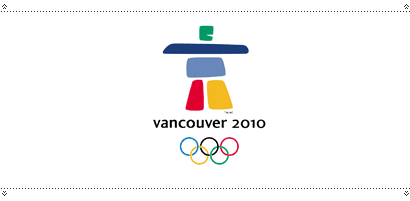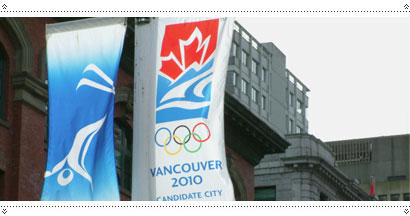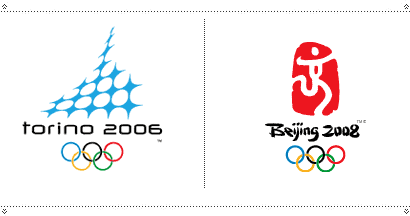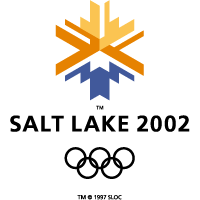This post goes over some already-well stomped stomping grounds, and yet I still think it’s worth telling. It’s the story of a logo, a nation, a contest and a princess. Ok, well, maybe no princess. We’ll see.
By now most of you are semi-familiar with the story of the logo contest for the Vancouver 2010 Olympics, and the furor it provoked last year. Tan covered it in brief here.
And by now, most of you have seen the resulting logo; a contest “winner” chosen out of 1,600 entries submitted by:
Part of the design brief, from the Submission Guidelines follows:
- Capture and reflect the unique image and spirit of Canada, Vancouver and Whistler
- Capture both Canada’s passion for winter sport, and the energy and excitement of the Olympic Winter Games
- Reflect Canada’s love and commitment towards our spectacular natural environment
- Embody Canada’s values and aspirations, celebrating our diversity and inclusiveness
- Provide a broad symbolic platform for interpretive storytelling – an emblem that can convey a range of meanings
[…]
OUR CONCEPTFrom Sea to Sky
Where the sea meets the sky, Canada invites the world for the XXI Olympic Winter Games and the X Paralympic Winter Games. From the sparkling oceanfront skyline of Vancouver to the soaring snow-capped peaks of Whistler’s Coast Mountains, Vancouver 2010 offers a breathtaking theatre for the world’s greatest event. Set between sea and sky, our Games will be a natural reflection of the Olympic journey – from the depths of motivation to the heights of aspiration. In 2010, we hope the beauty of our home will inspire athletes and fans as they live their Olympic and Paralympic dreams.

The new mark for the Vancouver 2010 Olympics was designed by Elena Rivera MacGregor and Gonzalo Alatorre (who often does not get credit for the design).
My first reaction? “Gee, I didn’t know the Games were taking place in Nunavut.” Where’s Nunavut? It’s up north, where there’s lots of snow and not a whole lot of landmarks. The Inuit used to build these things called “inukshuks” which were erected, as arctic ethnogeographer Norman Hallendy puts it, to represent “that which stands in the capacity of a person.” Commonly interpreted as a guide to help people find their way through the wilderness, they stand to instruct others about all sorts of things (Mr. Hallendy said that a Stop sign is a kind of inukshuk).
However, the exact semantics surrounding an Inuit artefact is one of the details of the surrounding furor over this logo. The logo, which all of us are calling an inukshuk, is actually an inunnguaq—a pile of stones in the shape of a man, with, apparently “all the spiritual gravity of a tombstone.”
The distinct connection with northern Canada (and ice and igloos) is the dominant reaction from those who object to the logo. That and remarks about “PacMan,” “Gumby,” “Frankenstein” and a host of other unsavoury characters.
A number of the contest judges had hoped for a West Coast native influence (of which there were many), and as ripping off native art while ghettoizing the actual people is a common practice here, I was slightly surprised the logo didn’t go that route.
The cultural appropriation of native (or First Nations) art is a big issue in Canada, particularly on the West Coast where, in particular, the beautiful and symbolic Haida art has become emblematic of the region. However, there are, apparently, tribal rules that “prohibit those who are not of Haida ancestry from working with the sacred Haida designs and symbols.” That doesn’t seem to stop people though.
The fact is, we seem to have trouble identifying ourselves without turning to the cultures that existed here before “we” arrived. Aside from many other accomplishments, the First Nations people seem to have achieved, hundreds of years ago, what we cannot: a distinct cultural graphic identity.
All of this leads from design to some very sticky politics, and the First Nations peoples seem to be split on their verdict of the Olympic logo. Despite the fact that there was a Haida artist on the panel of judges, many are ticked off that it’s not a West Coast native design, with one Squamish hereditary chief, Gerald Johnston, denouncing the inukshuk (whatever) symbol as an “act of aggression against our sovereignty” and likened it to “Russians planting their flag on the parliament buildings … without permission.”
One person notes that had the games been scheduled to take place in Iqaluit, and the logo was a Haida design, it would seem odd. True enough. Others note that the designers are not even Inuit (they are, in fact, immigrants from Mexico); true again, though Nunavut’s Premier Paul Okalik is just pleased to be represented.
Presumably those who are unhappy that it’s not a native design would be equally unhappy if it were, and weren’t designed by a native person. Not that some of the submissions weren’t. A Squamish Nation artist, Wade Baker, is after-the-fact upset that upon entering the contest, he had to sign over all rights to his designs to VANOC. His designs are, um … family crests. Doh! Incredibly, he knew what he was doing before submitting them. Now he wants them back, and good luck to him is all I have to say.
Many are calling for a return to the Vancouver Olympic bid logo, the icons for which were mired in their own debacle: the Haida-inspired designs were drawn by a native artist, but deemed irreproducable and had to be redrawn by someone else. More fur flew.

But those in favour of the new logo say that it is a symbol of hospitality and friendship (among other, less believable interpretations), and that it is uniquely Canadian—although, actually it appears in many far northern regions across the world.
In the end, this was a contest you can’t win. The Turin Olympic logo has been likened to a piece of Swiss cheese, the Beijing logo has been criticized for having wobbly legs. Here, and no doubt in other countries, citizens are calling to be allowed to see all the logos (or at least the top 3) and vote on their favourites. Lord have mercy.

Ultimately, I have to wonder if the problem isn’t in what we call this mark, and the criteria surrounding it. To attempt to come up with something that is meant to represent a nation, even for a brief time, is not really a logo in my mind. It’s more of a mascot or a flag (and apparently we had quite the uproar here in 1967 when we got our maple leaf flag, but I think I can be forgiven for not remembering that), and if it’s going to be some democratic process with voting and everything, maybe you should take it to National ballot. Seriously.
Or maybe it’s a money-generating unique identifier (a logo?), and should be described as such “… to create a uniquely loveable character which will compel people to buy t-shirts …” in which case it should not be a contest, but should be heavily focus-group tested. Then at least we won’t have to go through all this “national pride” and “representation” debate. (And will this mark sell t-shirts? Answer = yes.)
As for the princess … well, all of this disturbs her, like something uncomfortable under her mattress.
Thanks to Matt Warburton for the info, and the pile of newspaper articles.















Sorry, marian — the thread you linked to is when I covered a UN logo competition, not the VANOC logo. I don't remember whether or not we had an actual thread about the VANOC on SU, though we probably hijacked a semi-related thread at the time.
I did forward a request for everyone to submit a protest letter to VANOC on the issue — which many of us did. Matt ended up spearheading the issue at a press conference, got covered by the paper, and the rest is history.
On May.16.2005 at 10:14 AM